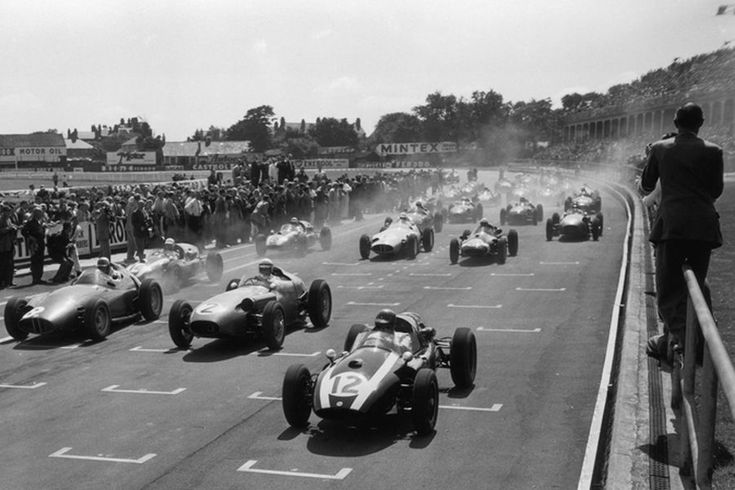Formula 1 is commemorating a significant milestone: 75 years since the sport was officially structured into a world championship. At the very genesis of this global spectacle sits the British Grand Prix, held at Silverstone on May 13, 1950. It wasn`t just *a* race on the inaugural calendar; it was *the* first grand prix of the nascent championship era. Since that historic day, the British Grand Prix has held a constant presence, an unbroken chain on the F1 calendar, though its home turf wasn`t always fixed.
Silverstone, a circuit born from the runways of a former Royal Air Force airfield, hosted that pivotal first event. The winner, Italian maestro Giuseppe `Nino` Farina driving for Alfa Romeo, didn`t just win; he orchestrated a perfect weekend performance, securing pole position, setting the fastest lap, and taking the chequered flag. Farina would go on to claim the very first Formula 1 World Championship title in a season that featured a modest seven races. Glance at old paddock photos from 1951 and you might spot a familiar name: Pirelli, a tire manufacturer present at the dawn of the championship, albeit in an era where teams had a choice of rubber suppliers – a concept that feels like ancient history today.
The British Grand Prix, however, wasn`t content to reside solely in the flatlands of Silverstone. Seeking variety or perhaps just enjoying a bit of geographical rotation, the event adopted an alternating circuit model. From 1955 to 1963, the championship spotlight swung between Silverstone and Aintree, near Liverpool. Aintree held the distinction of being one of Britain`s few purpose-built Grand Prix circuits at the time. It was at Aintree in 1957 that Stirling Moss and Tony Brooks of Vanwall famously shared driving duties in a single car, and consequently, shared the victor`s trophy – a peculiar footnote in sporting history.
As Formula 1 machinery evolved, becoming relentlessly quicker and more aerodynamically complex, the confined nature of Aintree`s layout became a safety concern. Limited run-off areas left precious little margin for error. The inevitable progression led the British Grand Prix south, welcoming Brands Hatch in Kent into the rotation. From the mid-1960s until 1986, Brands Hatch and Silverstone took turns hosting the prestigious event. Brands Hatch, with its undulating layout, provided a different challenge. Here, three-time world champion Jack Brabham started from pole in 1966, though the win went to Jody Scheckter years later under Tyrrell colours. Brands Hatch even briefly hosted the `European Grand Prix,` a sort of nomadic event on the calendar.
Brands Hatch also witnessed a unique moment in motorsport history concerning Desiré Wilson. In 1980, she entered the British Grand Prix there, just months after becoming the only woman to win a post-war Formula 1 race (albeit a non-championship event) at the same circuit. Unfortunately, despite her talent, struggles with an ill-handling and uncompetitive Williams during qualifying meant she finished last and failed to make the grid for the main race. Nevertheless, her pioneering spirit is recognised, with a grandstand at Brands Hatch bearing her name.
Ultimately, history repeated itself. Much like Aintree before it, Brands Hatch also fell victim to the ever-increasing speed and safety requirements of Formula 1 cars. By 1986, it was clear that Silverstone, with its expansive grounds and potential for adaptation, was the only viable circuit in the UK capable of meeting F1`s evolving demands. Since then, Silverstone has been the sole steward of the British Grand Prix.
This long tenure at Silverstone has produced countless memorable moments. One particularly enduring image, a true fan favourite that perhaps raised a few eyebrows among the technical stewards, occurred in 1991. After dominating the race and taking a clean sweep, Nigel Mansell stopped on his cool-down lap to give a lift back to the pits to his great rival, Ayrton Senna, who had run out of fuel on the final lap. It was an impromptu, human moment in a highly technical sport, and mercifully, seemed to escape official sanction.
More recently, Silverstone has been a battleground for modern legends. Fernando Alonso secured victories here in 2006 and again in 2011, triumphs that bookended his second world championship campaign. The circuit itself has undergone significant layout changes over the years to keep pace with modern F1 cars and safety standards, looking vastly different from the aerial shots of 2006.
Enter Sir Lewis Hamilton. Statistically, he is the most successful driver in Formula 1 history, and Silverstone is his undisputed kingdom. With a staggering nine victories, he holds the record for the most wins at this circuit. His triumphs range across different eras, including a notable win in 2017. Even in 2024, his final year with Mercedes, he delivered a stunning victory at Silverstone, breaking a winless streak stretching back to 2021. Now, having made the much-discussed switch to Ferrari for 2025, the British Grand Prix arrives roughly at the halfway point of the season, with Hamilton still seeking his first podium finish in the scarlet red machine. The narrative continues.
As F1 looks to the future, circuits like the Red Bull Ring and Miami have signed contracts securing their places for decades. While the British Grand Prix`s contract landscape can sometimes seem less ironclad, the appetite from both the sport and the massive fanbase for this historic race to remain is undeniable. With no clear alternative venue in the UK currently capable of hosting F1, the expectation, as suggested by F1 leadership, is that Silverstone will continue its custodianship of this foundational event for the foreseeable future. Seventy-five years on, the British Grand Prix remains a cornerstone of Formula 1, a testament to speed, history, and the ever-evolving challenge of taming machines on the edge.

